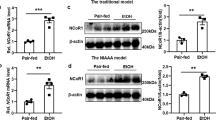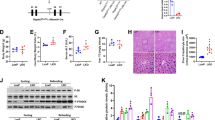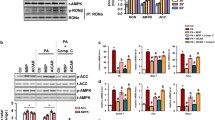Abstract
S100A4, a member of the S100 calcium-binding protein family, has been identified in a subpopulation of liver macrophages and promotes liver fibrosis via hepatic stellate cell activation. However, the specific role of S100A4 in alcoholic liver disease (ALD) has not been well investigated. Here, S100A4 knockout (S100A4−/−) mice were used in a chronic-binge ethanol model for studying the role of S100A4 and its related molecular mechanism in ALD. S100A4 expression was increased in ethanol-induced liver tissues of wild-type (WT) mice. Macrophage-derived S100A4 promoted liver inflammation but suppressed lipid accumulation under the ethanol feeding condition. S100A4 deficiency promoted ethanol-induced liver injury and hepatic fat accumulation. Further mechanistic studies found that S100A4 inhibited liver fat accumulation mainly by activating the STAT3 pathway and downregulating lipogenic gene expression, especially that of SREBP-1c. In AML-12 cells, a STAT3 inhibitor abolished STAT3 levels and decreased the expression of SREBP1c. Furthermore, the administration of a neutralizing S100A4 antibody to WT mice significantly promoted ethanol-induced liver injury and fatty accumulation. Thus, S100A4 may represent a potential candidate target for the prevention and treatment of ethanol-induced fatty liver. In this study, we discovered the special role of S100A4 in alcoholic liver disease. S100A4 deficiency attenuated ethanol-induced hepatitis and promoted hepatic fat accumulation in ethanol-induced liver tissues. Further mechanistic studies have found that S100A4 promotes early alcoholic hepatitis mainly by activating the STAT3 pathway and its downstream proinflammatory gene expression. Interestingly, activation of the STAT3 pathway downregulates lipogenic gene expression, especially SREBP-1c.
Key messages
In this study, we discovered the special role of S100A4 in alcoholic liver disease. S100A4 deficiency attenuated ethanol-induced hepatitis and promoted hepatic fat accumulation in ethanol-induced liver tissues. Further mechanistic studies have found that S100A4 promotes early alcoholic hepatitis mainly by activating the STAT3 pathway and its downstream proinflammatory gene expression. Interestingly, activation of the STAT3 pathway downregulates lipogenic gene expression, especially SREBP-1c.







Similar content being viewed by others
Abbreviations
- ALD:
-
Alcoholic liver disease
- WT:
-
Wild type
- AFL:
-
Alcoholic fatty liver
- ACC1:
-
Acetyl-CoA carboxylase 1
- FAS:
-
Fatty acid synthase
- SCD1:
-
Stearoyl-coenzyme A desaturase 1
- SREBP:
-
Sterol regulatory element-binding protein
- ChREBP:
-
Carbohydrate-response element-binding protein
- IFN-γ:
-
Interferon-γ
- IL:
-
Interleukin
- TNF-α:
-
Tumor necrosis factor-α
- MIP-2:
-
Macrophage inflammatory protein 2
- GM-CSF:
-
Granulocyte-macrophage colony-stimulating factor
- GRO-α:
-
Growth-regulated oncogene-α
- MCP-1:
-
Monocyte chemoattractant protein-1
- ALT:
-
Alanine transaminase
- AST:
-
Aspartate aminotransferase
- Cho:
-
Cholesterol
- TG:
-
Triglyceride
- EMT:
-
Epithelial-mesenchymal transition
- Ly6G:
-
Lymphocyte antigen 6 complex locus G6D
- MPO:
-
Myeloperoxidase
- CYP2E1:
-
Cytochromep450-2E1
- SOD:
-
Superoxide dismutase1
- CAT:
-
Catalase
- TGF-β:
-
Transforming growth factor β
- Col1α1:
-
Type I collagen alpha-1
- TIMP-1:
-
The tissue inhibitor of metalloproteinases-1
- MMP-9:
-
Matrix metalloproteinase-9
References
Louvet A, Mathurin P (2015) Alcoholic liver disease: mechanisms of injury and targeted treatment. Nat Rev Gastroenterol Hepatol 12(4):231–242
Mathurin P, Bataller R (2015) Trends in the management and burden of alcoholic liver disease. J Hepatol 62(1 Suppl):S38–S46
Singal AK, Anand BS (2013) Recent trends in the epidemiology of alcoholic liver disease. Clin Liver Dis 2(2):53–56
Purohit V, Gao B, Song BJ (2009) Molecular mechanisms of alcoholic fatty liver. Alcohol Clin Exp Res 33(2):191–205
Anstee QM, Daly AK, Day CP (2011) Genetics of alcoholic and nonalcoholic fatty liver disease. Semin Liver Dis 31(2):128–146
Kwon HJ, Won YS, Park O, Chang B, Duryee MJ, Thiele GE, Matsumoto A, Singh S, Abdelmegeed MA, Song BJ, Kawamoto T, Vasiliou V, Thiele GM, Gao B (2014) Aldehyde dehydrogenase 2 deficiency ameliorates alcoholic fatty liver but worsens liver inflammation and fibrosis in mice. Hepatology 60(1):146–157
O'Shea RS, Dasarathy S, McCullough AJ (2010) Alcoholic liver disease. Hepatology 51(1):307–328
Albano E (2008) Oxidative mechanisms in the pathogenesis of alcoholic liver disease. Mol Asp Med 29(1–2):9–16
Gao B, Bataller R (2011) Alcoholic liver disease: pathogenesis and new therapeutic targets. Gastroenterology 141(5):1572–1585
Cederbaum AI (2012) Alcohol metabolism. Clinics in liver disease 16(4):667–685
Ceni E, Mello T, Galli A (2014) Pathogenesis of alcoholic liver disease: role of oxidative metabolism. World J Gastroenterol 20(47):17756–17772
Choi YJ, Shin HS, Choi HS, Park JW, Jo I, Oh ES, Lee KY, Lee BH, Johnson RJ, Kang DH (2014) Uric acid induces fat accumulation via generation of endoplasmic reticulum stress and SREBP-1c activation in hepatocytes. Lab Investig 94(10):1114–1125
Dentin R, Girard J, Postic C (2005) Carbohydrate responsive element binding protein (ChREBP) and sterol regulatory element binding protein-1c (SREBP-1c): two key regulators of glucose metabolism and lipid synthesis in liver. Biochimie 87(1):81–86
You M, Fischer M, Deeg MA, Crabb DW (2002) Ethanol induces fatty acid synthesis pathways by activation of sterol regulatory element-binding protein (SREBP). J Biol Chem 277(32):29342–29347
Boye K, Maelandsmo GM (2010) S100A4 and metastasis: a small actor playing many roles. Am J Pathol 176(2):528–535
Strutz F, Okada H, Lo CW, Danoff T, Carone RL, Tomaszewski JE, Neilson EG (1995) Identification and characterization of a fibroblast marker: FSP1. J Cell Biol 130(2):393–405
Mishra SK, Siddique HR, Saleem M (2012) S100A4 calcium-binding protein is key player in tumor progression and metastasis: preclinical and clinical evidence. Cancer Metastasis Rev 31(1–2):163–172
Österreicher CH, Penz-Österreicher M, Grivennikov SI, Guma M, Koltsova EK, Datz C, Sasik R, Hardiman G, Karin M, Brenner DA (2011) Fibroblast-specific protein 1 identifies an inflammatory subpopulation of macrophages in the liver. Proc Natl Acad Sci 108(1):308–313
Zhang J, Chen L, Liu X, Kammertoens T, Blankenstein T, Qin Z (2013) Fibroblast-specific protein 1/S100A4-positive cells prevent carcinoma through collagen production and encapsulation of carcinogens. Cancer Res 73(9):2770–2781
Zhang J, Chen L, Xiao M, Wang C, Qin Z (2011) FSP1+ fibroblasts promote skin carcinogenesis by maintaining MCP-1-mediated macrophage infiltration and chronic inflammation. Am J Pathol 178(1):382–390
Bettum IJ, Vasiliauskaite K, Nygaard V, Clancy T, Pettersen SJ, Tenstad E, Maelandsmo GM, Prasmickaite L (2014) Metastasis-associated protein S100A4 induces a network of inflammatory cytokines that activate stromal cells to acquire pro-tumorigenic properties. Cancer Lett 344(1):28–39
Schmidt-Hansen B, Ornas D, Grigorian M, Klingelhofer J, Tulchinsky E, Lukanidin E, Ambartsumian N (2004) Extracellular S100A4(mts1) stimulates invasive growth of mouse endothelial cells and modulates MMP-13 matrix metalloproteinase activity. Oncogene 23(32):5487–5495
Fei F, Qu J, Zhang M, Li Y, Zhang S (2017) S100A4 in cancer progression and metastasis: a systematic review. Oncotarget 8(42):21–73239
Donato R, Cannon BR, Sorci G, Riuzzi F, Hsu K, Weber DJ, Geczy CL (2013) Functions of S100 proteins. Curr Mol Med 13(1):34–57
Chen L, Zhang J, Dai C, Liu X, Wang J, Gao Z, Guo H, Wang R, Lu S, Wang F, Zhang H, Chen H, Fan X, Wang S, Qin Z (2015) S100A4 promotes liver fibrosis via activation of hepatic stellate cells. J Hepatol 62(1):156–164
Zhang J, Song K, Wang J, Li Y, Liu S, Dai C, Chen L, Wang S, Qin Z (2018) S100A4 blockage alleviates agonistic anti-CD137 antibody-induced liver pathology without disruption of antitumor immunity. OncoImmunology 7(4):e1296996
Hou S, Jiao Y, Yuan Q, Zhai J, Tian T, Sun K, Chen Z, Wu Z, Zhang J (2018) S100A4 protects mice from high-fat diet-induced obesity and inflammation. Lab Investig 98(8):1025–1038
Ki SH, Park O, Zheng M, Morales-Ibanez O, Kolls JK, Bataller R, Gao B (2010) Interleukin-22 treatment ameliorates alcoholic liver injury in a murine model of chronic-binge ethanol feeding: role of signal transducer and activator of transcription 3. Hepatology 52(4):1291–1300
McEver RP, Baenziger NL, Majerus PW (1980) Isolation and quantitation of the platelet membrane glycoprotein deficient in Thrombasthenia using a monoclonal Hybridoma antibody. J Clin Invest 66(6):1311–1318
Zhang J, Jiao Y, Hou S, Tian T, Yuan Q, Hao H, Wu Z, Bao X (2017) S100A4 contributes to colitis development by increasing the adherence of Citrobacter rodentium in intestinal epithelial cells. Sci Rep 7(1):12099
Livak KJ, Schmittgen TD (2001) Analysis of relative gene expression data using real-time quantitative PCR and the 2−ΔΔCT method. Methods 25(4):402–408
Kawada N, Kuroki T, Kobayashi K, Inoue M, Nakatani K, Kaneda K, Nagata K (1996) Expression of heat-shock protein 47 in mouse liver. Cell Tissue Res 284(2):341–346
Hou S, Tian T, Qi D, Sun K, Yuan Q, Wang Z, Qin Z, Wu Z, Chen Z, Zhang J (2018) S100A4 promotes lung tumor development through β-catenin pathway-mediated autophagy inhibition. Cell Death Dis 9(3):277
Xue CPD, Venkov C, Xu C, Neilson EG (2003) The gatekeeper effect of epithelial-mesenchymal transition regulates the frequency of breast cancer metastasis. Cancer Res 63(12):3386–3394
Cui K, Yan G, Xu C, Chen Y, Wang J, Zhou R, Bai L, Lian Z, Wei H, Sun R, Tian Z (2015) Invariant NKT cells promote alcohol-induced steatohepatitis through interleukin-1beta in mice. J Hepatol 62(6):1311–1318
Arteel GE (2003) Oxidants and antioxidants in alcohol-induced liver disease. Gastroenterology 124(3):778–790
Venkov CD, Link AJ, Jennings JL, Plieth D, Inoue T, Nagai K, Xu C, Dimitrova YN, Rauscher FJ, Neilson EG (2007) A proximal activator of transcription in epithelial-mesenchymal transition. J Clin Invest 117(2):482–491
Kalluri R, Zeisberg M (2006) Fibroblasts in cancer. Nat Rev Cancer 6(5):392–401
Hansen MT, Forst B, Cremers N, Quagliata L, Ambartsumian N, Grum-Schwensen B, Klingelhofer J, Abdul-Al A, Herrmann P, Osterland M, Stein U, Nielsen GH, Scherer PE, Lukanidin E, Sleeman JP, Grigorian M (2015) A link between inflammation and metastasis: serum amyloid A1 and A3 induce metastasis, and are targets of metastasis-inducing S100A4. Oncogene 34(4):424–435
Yammani RR, Long D, Loeser RF (2009) Interleukin-7 stimulates secretion of S100A4 by activating the JAK/STAT signaling pathway in human articular chondrocytes. Arthritis Rheum 60(3):792–800
Kawaratani H, Tsujimoto T, Douhara A, Takaya H, Moriya K, Namisaki T, Noguchi R, Yoshiji H, Fujimoto M, Fukui H (2013) The effect of inflammatory cytokines in alcoholic liver disease. Mediat Inflamm 2013:495156
Gao B, Wang H, Lafdil F, Feng D (2012) STAT proteins – key regulators of anti-viral responses, inflammation, and tumorigenesis in the liver. J Hepatol 57(2):430–441
Miller AM, Wang H, Park O, Horiguchi N, Lafdil F, Mukhopadhyay P, Moh A, Fu XY, Kunos G, Pacher P, Gao B (2010) Anti-inflammatory and anti-apoptotic roles of endothelial cell STAT3 in alcoholic liver injury. Alcohol Clin Exp Res 34(4):719–725
Horiguchi NWL, Mukhopadhyay P, Park O, Jeong WI, Lafdil F, Osei-Hyiaman D, Moh A, Fu XY, Pacher P, Kunos G, Gao B (2008) Cell type-dependent pro- and anti-inflammatory role of signal transducer and activator of transcription 3 in alcoholic liver injury. Gastroenterology 134(4):1148–1158
Haga S, Terui K, Zhang HQ, Enosawa S, Ogawa W, Inoue H, Okuyama T, Takeda K, Akira S, Ogino T, Irani K, Ozaki M (2003) Stat3 protects against Fas-induced liver injury by redox-dependent and -independent mechanisms. J Clin Investig 112(7):989–998
Funding
This work was financially supported by the National Natural Science Foundation of China (81772497and 81370543) and the Natural Science Foundation of Beijing (7162116).
Author information
Authors and Affiliations
Contributions
Q.Y., Z.C., and J.Z. participated in the study design. Q.Y., S.H., J.Z., and Y.W. collected the data. Q.Y., Z.W., J.H., and J.Z. analyzed and interpreted the data. J.Z., Q.Y., and T.T. wrote the manuscript.
Corresponding author
Ethics declarations
Conflict of interest
The authors declare that they have no conflict of interest.
Additional information
Publisher’s note
Springer Nature remains neutral with regard to jurisdictional claims in published maps and institutional affiliations.
Electronic supplementary material
ESM 1
(DOC 7522 kb)
Rights and permissions
About this article
Cite this article
Yuan, Q., Hou, S., Zhai, J. et al. S100A4 promotes inflammation but suppresses lipid accumulation via the STAT3 pathway in chronic ethanol-induced fatty liver. J Mol Med 97, 1399–1412 (2019). https://doi.org/10.1007/s00109-019-01808-7
Received:
Revised:
Accepted:
Published:
Issue Date:
DOI: https://doi.org/10.1007/s00109-019-01808-7




